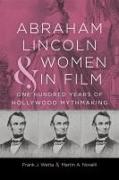- Start
- Abraham Lincoln and Women in Film
Abraham Lincoln and Women in Film
Angebote / Angebote:
Frank Wetta and Martin Novelli's "Abraham Lincoln and Women on Film" examines how depictions of women in Hollywood movies helped create the myth of Lincoln. They specifically explore D. W. Griffith's Abraham Lincoln (1930), John Ford and Larmar Trotti's Young Mr. Lincoln (1939), Robert Sherwood's Abe Lincoln in Illinois (1940), Shirley Temple's The Littlest Rebel (1933) and The Blue Bird (1940), and Stephen Spielberg's Lincoln (2012). In addition, they analyze four television productions: James Agee's Abraham Lincoln (1955), Carl Sandburg's Lincoln (1974), James Prideaux's The Last of Mrs. Lincoln (1976), and Gore Vidal's Lincoln (1988). In studying these depictions, Wetta and Novelli focus on the female characters. They are especially interested in female characters' backstories, the political and cultural climate in which the films appeared, and the contest between the moviemakers' imaginations and the varieties of historical truth. The women of Lincoln's life are the center of the study-his mother, Nancy Hanks Lincoln, his stepmother, Sarah Bush Lincoln, his lost loves, Ann Rutledge and Mary Owens, and his wife and widow, Mary Todd Lincoln. Later, while exploring Lincoln's legacy, Wetta and Novelli focus on the 1930s child star Shirley Temple and the 1950s movie star Marilyn Monroe, the latter of whom had a well-publicized fascination with the sixteenth president. Wetta and Novelli's work is the first to deal extensively with the women in Lincoln's life on screen. They are also among the first to examine how scholarly and popular biography influenced films about Lincoln and added to the creation of popular depictions of him. "Abraham Lincoln and Women on Film" will find a wide readership among Lincoln scholars and academics who study film and popular culture"--
Noch nicht erschienen, Februar 2024
